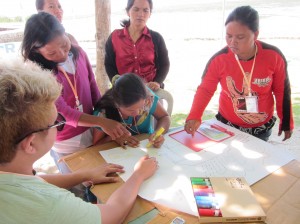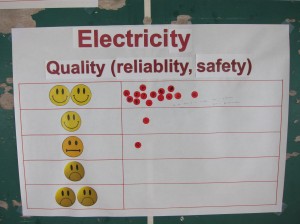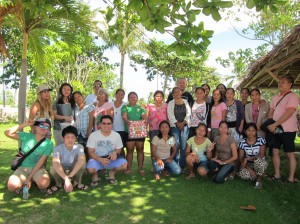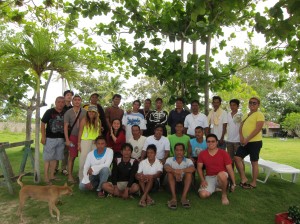As part of the post2015 project, our lab has been conducting the bottom-up research to contribute to the Sustainable Development Goal (SDG) post year 2015.
Last year we went to Surabaya, Indonesia to work with the urban community in a government-funded flat for people convicted from the illegal housings in the riverbanks and the other city area. This year, January 22nd to 28th, we visited the Philippines.
The community we are working with in the Philippines, lives in Pangan-an island which is located near Cebu-Mactan island in Lapu – lapu city. This island was also the case study of our former Ph.D. graduate, William who introduced the solar led lamp rental as an attempt in providing lights, overcoming the deteriorated battery of the Solar panel donated by the Belgian government in 1998.
This time, we wanted to know the priorities, challenges, and goals of the Pangan-an island residents regarding the topics represented in the Millennium Development Goals (MDG) . MDG has been a top-down process and its generality is necessary to have a concise goals that everybody can relate to in terms of development. However, on the other hand, its implementation has been challenging also due to this “one-fits-all” manner. Our goal is to understand better the voices of the real people, in how far they are reflected in the past MDG and what kind of insights we can provide to the development of SDG post 2015.
To reach the island, we had to ride a-one motored boat for about an hour. When the tide was too low, the boat had to be pushed by hand so that it can move. Later on, I was curious about the topography of the island, and to my surprise, this island turns out to be a small part of a slightly bigger island, with a lot of sand under the water.
view the link below to see where the island is located, zoom out and maybe you can imagine how the island looked like a hundred years a go and maybe a hundred years from now:
https://mapsengine.google.com/map/edit?mid=zvQtX89hZH5U.kvqbrztOsnyk
There have been surprising findings we learned about the Pangan-an island community. Including the fact that there is no toilet (the forest and the beach becomes the toilet), that there is no light after the sun sets, and there is no water during the dry season because rain is their source of water. Income is very dependent on the sea, when the weather does not allow, people cannot get fish, thus no income for that day. To cook, mostly people use fire wood, but when it becomes very windy, those who can afford would use a portable gas stove like the one we use for nabe dish in Japan! The saddest story I heard from the community is that some mothers would die during the emergency of delivering the baby. Many would give birth on their way to the main island in the boat but could not survive because of heavy bleeding.
Despite of the limitation of the comfort and safety of life, people are very happy. The bonding and social support within the community was very much felt. People likes to vote double smiles on our smiley chart regarding affordability, quality, and availability of water, food, and energy. But when asked about the challenges, they actually do have many challenges. When they were asked why they voted happy despite of the many problems they faces, they simply said: “we have gotten used to it and feel content about it. In the rainy season we do not get electricity but we get water. In the dry season, we do not get water but we get electricity!” So my charts were not complicated at all, it simply that people rate their condition as happy, despite of the challenges! This is one of the similarities that we found both in the urban Surabaya and rural Pangan-an island.
This finding reminds me of the book I am reading (inspired by Hirai san’s research progress presentation), “Small is beautiful, Economics as if people mattered”. It says something like, there should not be mass production, but production by the mass. When this happens, people do not feel like they are working because they actually enjoy and feeling happy. But although everyone is living happily, they agreed that things could be improved. Income stability is something everyone longed for, so that they can send the children for a better education. Many of the fathers wish that their daughters could become a nurse. This is one of the dreams they felt too far out of their reach (30,000 PhP/semester. Average income of a father is only 4800 PhP per month, feeding household members of 6 in average). But who knows, maybe some awareness or inspiration might arise from our 3 years workshop and the first nurse from Pangan-an island could be born in 2030?
Andante Hadi Pandyaswargo



